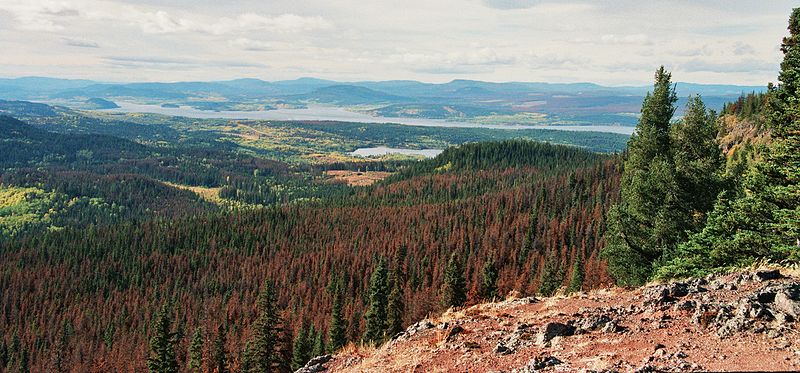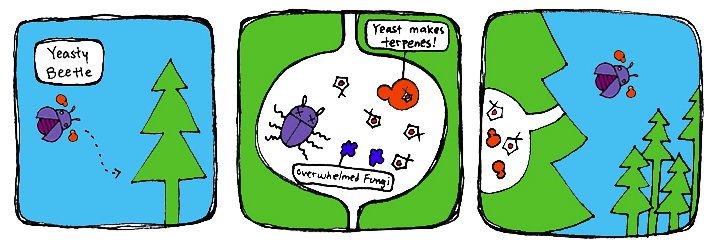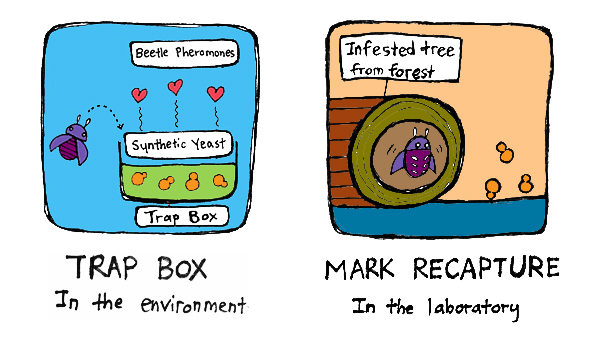Team:British Columbia/Story
From 2011.igem.org

British Columbia's Infested Forests: Attack of the Mountain Pine Beetle
A video of the B.C. Pine Beetle Epidemic up till 2010 produced by the UBC iGEM 2011 Beetle Epidemic Model.
The mountain pine beetle (MPB) outbreak in British Columbia, Canada is the largest and most widespread of its kind in the world. This epidemic has killed millions of hectares of lodgepole pine trees, endangering the forest health, which hosts a wide range of ecosystems, and threatening the economic, social, and cultural stability of our beautiful province. By 2015, according to the BC Ministry of Forests and Range, mortality of all merchantable pine trees is projected to be as high as 67%.
The Three Players Involved



From left to right: a view from Mount Fraser of dying pine trees turning red; a pine beetle; a lodgepole pine log showing the blue stain fungus in the sapwood (photo courtesy of Dr. Allan Carroll).
The blue stain fungus (Grosmannia clavigera) is one of three major fungal species that live in symbiosis with the MPB. This blue stain fungus plays a key role in the infestation. As beetles attack a tree, they introduce the blue stain fungus into the sapwood, which helps prevent the tree’s natural defences, production of sticky and toxic resin, from repelling and killing beetles. The fungus cuts off water and nutrient transport within the tree while beetle larvae feed off the tree. Within a year, the pine tree will die from lack of water and nutrient transport and its needles will turn red. Mature MPB will leave the dying tree and move on to the next host tree, carrying spores of the fungus with them. In the years following the attack, the tree will turn gray, lose foliage and the fungus will leave a bluish stain in the sapwood. Most of this wood becomes unsalvageable quickly primarily due to rot and degradation by fungi and other pests. The wood also cannot be exported outside North America. Furthermore, with vast amount of pines being killed, this has also become a fire hazard for BC. The MPB have always been present in nature, and this is not the first outbreak. In fact, there have been four outbreaks during the past century, with the last outbreak (from mid-1970's to late-1980's) causing the mortality of lodgepole pines over approximately 1.4 million hectares. This time, climate change leading to warmer winters has improved the survival of the beetle, and aggressive wildfire suppression has allowed much more of the pine forests to grow old and become susceptible to attack. Because of the warmer winters, the beetle population has grown substantially over the past 15 years. The government of Canada and BC’s Ministry of Forestry have already committed over $956 million dollars to mitigate the spread of the MPB to more pine trees in BC. However, no permanent solution has been found so far.
A tremendous amount of research has been invested in studying the genetics and molecular systems of the three players involved: the pine tree, the MPB, and the blue stain fungus. Interestingly, it was noted that not all pine trees in the outbreak area are infested with the MPB. This begs the question: why do some trees not get attacked by the MPB? Researchers have explored this question through genomic studies comparing attacked pines to those left unharmed. A greater expression of genes related to monoterpene production was observed in unharmed trees. In nature, these monoterpenes, a class within the family of terpeniods, are synthesized and secreted by trees as a defence mechanism against insect and fungi infestation within the tree. Despite this finding, the bluestain fungus has also adapted to the tree’s natural defenses by degrading these terpenoids and removing it from its system, allowing the fungi and the MPB to survive under these toxic conditions. Additionally, pine beetles choose their attack strategy based on their population size. When the pine beetle population is small, they choose to attack trees that have less defense and are more susceptible. However, when there are large numbers of pine beetles, they are able to attack healthier trees and overwhelm its defenses by sheer numbers. Based on this understanding of the beetle-fungi dynamic, it is possible to devise strategies to combat the epidemic by increasing levels of monoterpene production in trees.
For more resources on the pine beetle infestation, here is an interactive Mountain Pine Beetle Student Resource provided by Ministry of Forest: Pine Beetles in British Columbia, Canadian Forest Service, BC Market Outreach Network, and the COFI Mountain Pine Beetle Task Force.
Our combat against the Pine Beetle Epidemic
The Beetle's Strategy
The mountain pine beetle lives in symbiosis with the bluestain fungus which can break down monoterpenes produced by the tree to deter insect attacks. Their relationship allows the beetle to avoid the toxic effects of the monoterpenes, while the fungus is carried inside the tree where it can grow and colonize. The beetles lay their larvae that consume the fungus for nutrients. Once a tree has been successfully attacked, and female beetles have laid their eggs, the eggs hatch and the larvae consume the succulent tissues beneath the bark of the tree. After larvae have completed their development and transformed into adult beetles, they gain additional nutrients by feeding on the fungus, and in the process they collect fungal spores that they can carry to new trees. Meanwhile, the trees turn red and die because the fungus blocks transport of water and nutrients through the tree. Over the last decade, the pine beetle epidemic has spread rapidly through North American pine forests, causing mass destruction to forest health and reliant ecosystems.
Our Theoretical Strategy: iSynthase Yeast
To establish high levels of anti-beetle monoterpenes in the trees, we propose the introduction of our monoterpene-producing yeast into the environment. For this, we have two strategies: the iSynthase Trap Box and the Mark-Release-Recapture strategy. Both involve exposing beetles to the synthetic yeast and releasing them to the environment to disperse the yeast along with the pine beetle infestation.
Previous studies have shown inhibition of bluestain fungus growth upon interaction with certain concentrations of monoterpenes. Assuming that our yeast does inhibit the growth of bluestain fungus due to the monoterpenes produced, this will also subdue the mountain pine beetle population that depends on the blue-stain fungus. We predict that the spread of our yeast will be similar to the pine-beetle infestation, with the hope that it will spread from beetle to beetle. Therefore, the spread of our yeast product will fall once pine-beetle population declines.
The iSynthase Trap Box strategy places trap boxes at strategic locations in the forest to attract beetles with pheromones. These beetles enter the box and leave with the synthetic yeast.
The Mark-Release strategy involves collecting trees infested with beetles, rearing these in the lab and exposing them to our synthetic yeast, before releasing them back into the environment at strategic locations.
In both cases, the dispersal of beetles back into the environment comes with some risk. Beetles need to use their reserved energy to make several survival decisions including (i) does this forest contain susceptible tree species? (ii) are there other beetles to collaborate with? (iii) does the potential host tree have too much light and warmth? (iv) is this host tree over-populated? (v) what is the defensive capacity of the tree?
To evaluate the effectiveness of the synthetic yeast dispersal strategy, one way is to capture beetles in the environment (again either by using a trap box or collecting an infested tree) and determine what percentage carries the synthetic yeast after different periods of time since the start of the program.
A video of the B.C. Pine Beetle Epidemic up till 2010 produced by the UBC iGEM 2011 Beetle Epidemic Model.
The Three Players Involved



From left to right: a view from Mount Fraser of dying pine trees turning red; a pine beetle; a lodgepole pine log showing the blue stain fungus in the sapwood (photo courtesy of Dr. Allan Carroll).



From left to right: a view from Mount Fraser of dying pine trees turning red; a pine beetle; a lodgepole pine log showing the blue stain fungus in the sapwood (photo courtesy of Dr. Allan Carroll).
The blue stain fungus (Grosmannia clavigera) is one of three major fungal species that live in symbiosis with the MPB. This blue stain fungus plays a key role in the infestation. As beetles attack a tree, they introduce the blue stain fungus into the sapwood, which helps prevent the tree’s natural defences, production of sticky and toxic resin, from repelling and killing beetles. The fungus cuts off water and nutrient transport within the tree while beetle larvae feed off the tree. Within a year, the pine tree will die from lack of water and nutrient transport and its needles will turn red. Mature MPB will leave the dying tree and move on to the next host tree, carrying spores of the fungus with them. In the years following the attack, the tree will turn gray, lose foliage and the fungus will leave a bluish stain in the sapwood. Most of this wood becomes unsalvageable quickly primarily due to rot and degradation by fungi and other pests. The wood also cannot be exported outside North America. Furthermore, with vast amount of pines being killed, this has also become a fire hazard for BC. The MPB have always been present in nature, and this is not the first outbreak. In fact, there have been four outbreaks during the past century, with the last outbreak (from mid-1970's to late-1980's) causing the mortality of lodgepole pines over approximately 1.4 million hectares. This time, climate change leading to warmer winters has improved the survival of the beetle, and aggressive wildfire suppression has allowed much more of the pine forests to grow old and become susceptible to attack. Because of the warmer winters, the beetle population has grown substantially over the past 15 years. The government of Canada and BC’s Ministry of Forestry have already committed over $956 million dollars to mitigate the spread of the MPB to more pine trees in BC. However, no permanent solution has been found so far.
A tremendous amount of research has been invested in studying the genetics and molecular systems of the three players involved: the pine tree, the MPB, and the blue stain fungus. Interestingly, it was noted that not all pine trees in the outbreak area are infested with the MPB. This begs the question: why do some trees not get attacked by the MPB? Researchers have explored this question through genomic studies comparing attacked pines to those left unharmed. A greater expression of genes related to monoterpene production was observed in unharmed trees. In nature, these monoterpenes, a class within the family of terpeniods, are synthesized and secreted by trees as a defence mechanism against insect and fungi infestation within the tree. Despite this finding, the bluestain fungus has also adapted to the tree’s natural defenses by degrading these terpenoids and removing it from its system, allowing the fungi and the MPB to survive under these toxic conditions. Additionally, pine beetles choose their attack strategy based on their population size. When the pine beetle population is small, they choose to attack trees that have less defense and are more susceptible. However, when there are large numbers of pine beetles, they are able to attack healthier trees and overwhelm its defenses by sheer numbers. Based on this understanding of the beetle-fungi dynamic, it is possible to devise strategies to combat the epidemic by increasing levels of monoterpene production in trees.
For more resources on the pine beetle infestation, here is an interactive Mountain Pine Beetle Student Resource provided by Ministry of Forest: Pine Beetles in British Columbia, Canadian Forest Service, BC Market Outreach Network, and the COFI Mountain Pine Beetle Task Force.
Our combat against the Pine Beetle Epidemic
The Beetle's Strategy
The mountain pine beetle lives in symbiosis with the bluestain fungus which can break down monoterpenes produced by the tree to deter insect attacks. Their relationship allows the beetle to avoid the toxic effects of the monoterpenes, while the fungus is carried inside the tree where it can grow and colonize. The beetles lay their larvae that consume the fungus for nutrients. Once a tree has been successfully attacked, and female beetles have laid their eggs, the eggs hatch and the larvae consume the succulent tissues beneath the bark of the tree. After larvae have completed their development and transformed into adult beetles, they gain additional nutrients by feeding on the fungus, and in the process they collect fungal spores that they can carry to new trees. Meanwhile, the trees turn red and die because the fungus blocks transport of water and nutrients through the tree. Over the last decade, the pine beetle epidemic has spread rapidly through North American pine forests, causing mass destruction to forest health and reliant ecosystems.
Our Theoretical Strategy: iSynthase Yeast
To establish high levels of anti-beetle monoterpenes in the trees, we propose the introduction of our monoterpene-producing yeast into the environment. For this, we have two strategies: the iSynthase Trap Box and the Mark-Release-Recapture strategy. Both involve exposing beetles to the synthetic yeast and releasing them to the environment to disperse the yeast along with the pine beetle infestation.
Previous studies have shown inhibition of bluestain fungus growth upon interaction with certain concentrations of monoterpenes. Assuming that our yeast does inhibit the growth of bluestain fungus due to the monoterpenes produced, this will also subdue the mountain pine beetle population that depends on the blue-stain fungus. We predict that the spread of our yeast will be similar to the pine-beetle infestation, with the hope that it will spread from beetle to beetle. Therefore, the spread of our yeast product will fall once pine-beetle population declines.
The iSynthase Trap Box strategy places trap boxes at strategic locations in the forest to attract beetles with pheromones. These beetles enter the box and leave with the synthetic yeast.
The Mark-Release strategy involves collecting trees infested with beetles, rearing these in the lab and exposing them to our synthetic yeast, before releasing them back into the environment at strategic locations.
In both cases, the dispersal of beetles back into the environment comes with some risk. Beetles need to use their reserved energy to make several survival decisions including (i) does this forest contain susceptible tree species? (ii) are there other beetles to collaborate with? (iii) does the potential host tree have too much light and warmth? (iv) is this host tree over-populated? (v) what is the defensive capacity of the tree?
To evaluate the effectiveness of the synthetic yeast dispersal strategy, one way is to capture beetles in the environment (again either by using a trap box or collecting an infested tree) and determine what percentage carries the synthetic yeast after different periods of time since the start of the program.
 "
"


